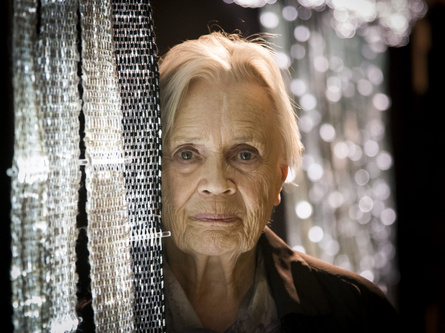Maija Lavonen – Quietly Monumental
Muualla

Experience the magical beauty of Maija Lavonen’s textile works! The exhibition is on view at the Architecture & Design Museum Helsinki at Korkeavuorenkatu 23.
Maija Lavonen (1931–2023) is one of Finland’s most prominent designers and an internationally recognized innovator in textile art. Over her long career, she developed new techniques, challenged the traditional rug tradition, and helped usher in a golden age of textile art in Finland. Throughout her life, she was a pioneer, creating groundbreaking light art using optical fibers even in her 80s.
A Master of Minimalism Inspired by Northern Nature
Maija Lavonen was a master of minimalism, drawing inspiration from her childhood experiences. Northern Finland’s nature – the sea, forests, and meadows – held a lifelong significance for her, continually influencing her work. Memories of colours and her encounters with nature were translated into her textile creations.
A Lifelong Trailblazer, an Example for Younger Generations
As an artist, Lavonen continually explored new means of expression and materials throughout her life. Her bold innovations, such as incorporating stone, steel, and optical fibers into textile art, required experimentation and craftsmanship. Her hands-on approach, her teaching at the University of Art and Design Helsinki, and the wide attention she received during the 1980s established her as a role model. She remains an inspiring figure for designers and artists alike.
The Golden Age of Textile Art in the 1980s
A strong cultural and artistic presence in society, combined with Finland’s construction boom during the 1980s, created a massive demand for public art and ushered in a golden age for textile art. Textile artists became celebrated figures of the time, appearing in the public spotlight. Maija Lavonen was one of the most successful artists of this era. She was commissioned to create large-scale works for locations such as the Parliament House, ministries, embassies, churches, and corporate headquarters. Thanks to Lavonen and her generation of artists, textile art is no longer viewed as a niche discipline but as an integral part of contemporary art.
A Legacy at Risk
Lavonen’s career left behind a rich material and cultural legacy. Today, however, many buildings from the 1980s are being demolished, putting the public art integrated into them, including textile works, at risk. This exhibition honours Maija Lavonen’s contributions and defends our shared cultural heritage. The Museum of Architecture and Design is deeply grateful for the donation of Lavonen’s artist archive.
The Archive Donation Made This Exhibition Possible
In 2023, the Design Museum received Maija Lavonen’s artist archive into its collection. This donation has enabled new research and interpretations of Lavonen’s life’s work, which the exhibition presents in unprecedented depth. The exhibition features Lavonen’s thoughts, new material on the process of creating art, and over twenty unique textile works and printed fabrics from the museum’s collection. Additional works are on loan from other collections and private individuals.
Why Does Architecture & Design Museum Helsinki Present a Maija Lavonen Exhibition?
Maija Lavonen’s long and remarkably innovative career as a designer and artist deserves its own exhibition. Lavonen was trained as a clothing designer and created printed fabrics for many manufacturers, including Marimekko. Early on, she expanded into designing other interior textiles and later moved on to artistic works that became permanent parts of built environments.
During the 1980s, textile art became a prominent feature of new architecture in both new buildings and renovation projects in Finland. Lavonen created numerous commissioned works for public spaces, corporate offices, and churches. This exhibition highlights the role of art in architecture and the collaboration between design fields in creating harmonious spaces: what defines the atmosphere of a space, how do materials and forms interact, and what did the textile artist think about their role?
From Maija Lavonen’s Archive:
“I am currently working on a textile for the staff dining hall at Valio’s new production facility in Laukaa. The work is a commissioned piece. I first visited the building in late winter to study its architecture, the sense of space in the dining hall, the materials used, and the way light enters the room. The building is purely functional – a machine – and the aim with the textile is to bring a sense of humanity to the industrial structure. The building, designed by Matti K. Mäkinen and architect Antti Katajamäki, will be inaugurated in October.” – Maija Lavonen, The Finnish Environment Today, undated manuscript, spring 1980
Exhibition Project Team
Curator: Harry Kivilinna
Exhibition Producer: Jenni Helenius
Head of Exhibitions: Suvi Saloniemi
Expert: Leena Svinhufvud
Exhibition Architecture: Aalto+Aalto
Graphic Design: Kobra Agency
Lighting Design: Pietu Pietiäinen, Pro Light
Exhibition Technician: Ville Särmä
AV Technician: Ilkka Pykäläinen
Registrar: Aino Pisilä
Conservation: Tarja Viitala, Chenyue Xu, Henna Koskinen, Ulla Vainikka
Collections: Joona Rantasalo, Susanna Thiel
Partners: SAAS Instruments, Tarkett
Thanks to: Kuutti Lavonen, Sussa Lavonen
Photo: Maija Lavonen participated in a group exhibition at the Hélène Aziza Gallery in Paris in 2012 with her optical fibre artwork. The exhibition also featured the French photographer Xavier Lambours, who took this photograph of Maija Lavonen during the exhibition. Image: Xavier Lambours.
